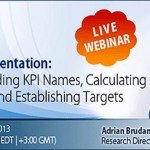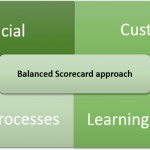6 pillars of the Performance Measurement Framework

In the latest research study (2015) initiated by The KPI Institute, 42% of professionals admitted to using the Balanced Scorecard. In spite of the popularity of this framework, there are many organizations in which performance management seems to be failing in producing the expected added value for the respective business. Less successful Balanced Scorecard implementations are mainly caused by the lack of leadership support, the limited ability to adapt the Balanced Scorecard to the organizational context and link it to other processes like budgeting or process management due to a poor understanding of this tool.
Similar factors, like the ones just mentioned, can operate as enablers or obstacles in implementing change within organizations or managing innovation. 32% of professionals questioned during our latest research study claimed that organizational culture is the main enabler of a performance measurement system.
In other words, no matter how sophisticated your tools are, whether your performance measurement system is supported by the Balanced Scorecard methodology, the Performance Prism or the EFQM – a performance oriented culture is vital for a successful performance measurement framework.
Developing the performance measurement capability in the organization consists in ensuring the right tools, processes and talent are in place.
The KPI Institute has consolidated its own Performance Measurement Framework, which relies on 6 pillars, each equally important in developing the performance measurement capability of an organization. Performance measurement is regarded as a distinct component, related to establishing KPIs and collecting performance data, which should be completed via strategy formulation (objectives setting) and performance improvement (reporting, decision-making and continuous learning).
- KPI Selection
This is an important pillar that ensures the relevancy of the entire framework by monitoring the right KPIs. KPI selection is a step that follows immediately after strategic objectives are established. In practice, this seems to be the most challenging aspect in working with KPIs for most professionals. Many organizations fail to deliver the right data for decision-making, despite having long time experience in using KPIs. Sometimes they focus on what is easy to measure or what has been always measured.
Tips:
- KPIs should be linked to objectives – when your strategy changes, the KPIs may change; even if the strategy has been the same for a longer period of time, your KPI set can evolve: you can measure the efficiency in reaching your objectives, but also its effectiveness.
- The KPI selection techniques – KPI clustering, Value Flow Analysis or KPI balancing can be used to provide more context to monitoring performance results and ensure a balanced approach to measurement.
- The right environment to identify the right KPIs – organize workshops, during which stakeholders can discuss and clarify each objective, brainstorm KPI examples and practice KPI selection techniques. These workshops will not only present meaningful KPIs but will also raise awareness on performance measurement among stakeholders and create a common business language in this field.
- KPI Documentation
Documenting the performance measurement approach for all the monitored KPIs sets the basis for a standardized and reliable KPI framework. KPI documentation forms will ensure a consistent measurement process and will act as clear procedures for data custodians.
Tips:
- Standardized KPI documentation forms – this type of template ensures all critical information related to measuring a KPI is captured and available to all parties involved in the performance measurement process.
- A centralized KPI repository – acting like an internal library; can become an important educational tool in measuring performance.
- Target Setting
Although it is part of the KPI documentation process, given the complexity of setting targets, it is regarded as a separate pillar. As target achievement is either formally or informally associated with employee performance and professional competencies, targets have a significant impact on how people behave.
Tips:
- Assesses the extent to which target-setting relies on data and ensures a stimulating environment to reach and exceed targets.
- Breakdown long term targets into short term targets, to be keep people engaged and reward small successes as well.
- Involve KPI owners into the target-setting process.
- Data Gathering
Along with KPI selection, this is among the most challenging processes in measuring performance. Common difficulties associated with data gathering are data timeliness, accuracy and completeness. The process to collect data for each KPI may prove to be costlier than expected compared to the benefits of having performance results.
Tips:
- Data sources should be identified for each KPI;
- The data collection process should be clearly mapped and communicated to data custodians to ensure that the information will be ready on time;
- Data custodians should be trained and engaged in an internal community of practice to support a continuous learning process. In this manner, any data collection difficulties can be discussed and addressed.
- KPI Data Visualization
Developing competencies in data visualization is an important pillar of the KPI Measurement Framework, because it supports the efficiency principle: data should be grasped immediately by managers. Measuring and reporting KPI results should be facilitated by the visual design used in scorecards, dashboards or reports.
Assess your company’s performance measurement maturity level by using our free self-assessment tool used for performance measurement audit!
Tips:
- Graphs should be selected considering the type of data displayed (bar-charts facilitate comparisons, line charts indicate with ease evolution over time, scatter graphs enable pattern identification);
- Simple backgrounds help the reader concentrate on the performance results;
- Each of the colors used should have a meaning and consistency and ought to be provided from one page to another;
- Legends should be included to enhance the understanding of data.
- Governance
The Performance Measurement Governance Frameworks identifies key stakeholders involved in the system and their roles and responsibilities in accordance to Figure 1.

Figure 1: Governance Framework
The State of KPIs and Performance Improvement Practice Report 2015 indicate that 55% of professionals have a dedicated office that manages strategy and performance management in organization. This trend is a common practice because such a governing body, which in some cases can be just one person, can provide specialized advice to managers on how to monitor performance and is responsible with maintaining an updated and relevant performance measurement framework.
Tips:
- Adapt the size of the Strategy and Performance Management Office to the organization’s size and needs in this area;
- Consider building a mixed team and bring together technical competencies as data analysis, performance management, strategic thinking and modern technology skills, with soft competencies like communication, mediation skills, coaching and training.
In the end, it can take year for an organization to reach the highest performance measurement maturity level. A performance-oriented organization needs to invest both in technology and its human capital, in order to support constant improvement initiatives. Such organizations are also very skillful in change management, in training employees on how to adopt new work methods, in addressing challenges and are also very adept at seeing the business environment and even themselves from varying perspectives.
Image source:

Tags: Balanced Scorecard, KPI, KPI framework, Performance Measurement






double flange damper valve manufacturer in ahmedabad
| #
Im obliged for the article post.Really thank you! Great.
Reply
retirement visa australia
| #
Thanks a lot for the blog.Really thank you! Great.
Reply
custom plastic parts manufacturing
| #
I really enjoy the blog article. Really Cool.
Reply
nsfw ai chat
| #
Very neat article.Really thank you! Fantastic.
Reply
nsfw ai
| #
I really like and appreciate your blog post.Really thank you! Fantastic.
Reply
what's a good hair dryer for travel
| #
I really enjoy the post. Will read on…
Reply
茶馆儿
| #
Appreciate you sharing, great blog post.Really looking forward to read more.
Reply
橙新聞
| #
I am so grateful for your blog post.Much thanks again. Much obliged.
Reply
instagram pro
| #
Thank you ever so for you post.Really thank you!
Reply
talkie ai
| #
Thanks a lot for the article.Really thank you! Cool.
Reply
pintar por numeros
| #
A big thank you for your article. Want more.
Reply
ai porn chat
| #
Im thankful for the blog.Really looking forward to read more.
Reply
ai porn chat
| #
Looking forward to reading more. Great article post.Really looking forward to read more. Keep writing.
Reply
nsfw ai chat
| #
I truly appreciate this blog post.Really thank you! Really Great.
Reply
High Waisted Menstrual Underwear
| #
Major thankies for the article post.Thanks Again. Want more.
Reply
andaman castle
| #
Fantastic blog.Much thanks again. Awesome.
Reply
signal crypto
| #
Very good article.Much thanks again. Keep writing.
Reply
duct system replacement service in Fort Pierce
| #
Really informative blog article.Really thank you!
Reply
vascular doctor
| #
Muchos Gracias for your article.Much thanks again. Cool.
Reply
mit college kothrud
| #
Awesome blog post.Really looking forward to read more. Want more.
Reply
acharya nrv school of architecture
| #
I really liked your article.Really thank you! Will read on…
Reply
name plate gift
| #
Great blog.Much thanks again. Cool.
Reply
nata 2021 syllabus
| #
Thank you ever so for you article post.Really thank you!
Reply
arenaplus nba
| #
Enjoyed every bit of your post.Really thank you! Cool.
Reply
Motchill
| #
I value the article post.Really looking forward to read more. Much obliged.
Reply
https://baixicans.com/
| #
Very informative blog post. Awesome.
Reply
ATOP北美留学公关中心
| #
I truly appreciate this blog post.Really looking forward to read more. Keep writing.
Reply
GB WhatsApp
| #
Very informative article.Really thank you! Great.
Reply
Fouad WhatsApp
| #
This is one awesome blog post.Much thanks again. Really Cool.
Reply
Baixar GB whatsapp
| #
Thank you ever so for you blog post.Thanks Again. Cool.
Reply
FM Whatsapp
| #
I truly appreciate this post. Much obliged.
Reply
NSFW Generator AI
| #
Major thanks for the article.Much thanks again.
Reply
Anime Ai
| #
Awesome blog.Much thanks again. Fantastic.
Reply
vijay hazare trophy live score
| #
Appreciate you sharing, great article post.Really looking forward to read more. Keep writing.
Reply
live score
| #
Major thanks for the article.Really thank you! Fantastic.
Reply
living room furniture
| #
Really enjoyed this blog post.Really looking forward to read more. Fantastic.
Reply
matka satka kalyan
| #
wow, awesome blog.Thanks Again. Cool.
Reply
madhur milan satta matka result
| #
Muchos Gracias for your blog.Really thank you!
Reply
upsc coaching centre in delhi
| #
Really informative article post.Really looking forward to read more. Awesome.
Reply
limousine rent in delhi
| #
Thanks-a-mundo for the blog post.Thanks Again. Will read on…
Reply
mini bus booking price
| #
wow, awesome blog post. Keep writing.
Reply
whatsapp marketing software
| #
Thanks so much for the blog.Really looking forward to read more. Awesome.
Reply
stud silver earrings for women
| #
A round of applause for your article. Really Cool.
Reply
hommar
| #
Major thankies for the blog.Thanks Again. Great.
Reply
官方現金網娛樂城
| #
Say, you got a nice blog post.Really thank you! Fantastic.
Reply
hommar
| #
Wow, great blog. Will read on…
Reply
affordable custom shirts
| #
I really like and appreciate your post.Really looking forward to read more. Great.
Reply
actionable items meaning
| #
Enjoyed every bit of your article.Really thank you! Want more.
Reply
how to use otter with zoom
| #
Great, thanks for sharing this blog post.Really looking forward to read more. Will read on…
Reply
ai girlfriend chat
| #
Thanks-a-mundo for the article post.Really thank you! Will read on…
Reply
nsfw ai chat
| #
Enjoyed every bit of your post.Really thank you! Want more.
Reply
Injection Machine manufacturer
| #
I truly appreciate this blog.Really looking forward to read more. Keep writing.
Reply
ai sex chat
| #
Thanks so much for the blog article.Thanks Again. Cool.
Reply
character ai no filter
| #
I truly appreciate this blog post.Thanks Again. Cool.
Reply
keeper ai test
| #
Thanks a lot for the article post.Much thanks again. Will read on…
Reply
keeper ai test
| #
Im thankful for the article. Fantastic.
Reply
AI sexting
| #
Very neat blog article. Want more.
Reply
spicy ai
| #
I am so grateful for your blog.Really looking forward to read more. Great.
Reply
character ai
| #
I appreciate you sharing this blog.Thanks Again. Will read on…
Reply
ai anime
| #
Thanks for the blog.Really looking forward to read more. Want more.
Reply
Ai girlfriend
| #
Very neat blog article.Really thank you!
Reply
c.ai
| #
Very good article post.Much thanks again. Great.
Reply
smash or pass ai
| #
Very informative article.Really looking forward to read more. Great.
Reply
affordable custom shirts
| #
Great, thanks for sharing this article.Really thank you! Really Great.
Reply
deep wave synthetic wig
| #
This is one awesome post.Thanks Again. Really Cool.
Reply
human hair wigs next day delivery
| #
I really enjoy the article.Really thank you! Fantastic.
Reply
vflower cosplay wig
| #
Great blog post.Really looking forward to read more. Want more.
Reply
868 double wire fencing
| #
Thanks for sharing, this is a fantastic blog article.Really thank you! Really Cool.
Reply
SLS Machinery Co.,Ltd
| #
Really enjoyed this blog.Really looking forward to read more. Really Cool.
Reply
SLS Machinery Co.,Ltd
| #
Very informative article.Really looking forward to read more. Really Cool.
Reply
优美之家
| #
Very good post.Really thank you! Much obliged.
Reply
优美之家
| #
I think this is a real great blog. Want more.
Reply
nsfw character ai
| #
Thanks again for the article.Really thank you!
Reply
nsfw character ai
| #
Thanks for sharing, this is a fantastic post.Thanks Again. Fantastic.
Reply
led light football showcase
| #
Thank you for your blog post. Keep writing.
Reply
huddles
| #
I really like and appreciate your blog article. Will read on…
Reply
香港現金網娛樂城
| #
Great post.Much thanks again. Cool.
Reply
benefits of light therapy for sleep
| #
Great, thanks for sharing this article.Really thank you! Want more.
Reply
smart sleep solutions for insomnia
| #
I value the blog. Really Cool.
Reply
amiri jeans
| #
wow, awesome article post.Thanks Again. Much obliged.
Reply
pia proxy s5
| #
Really enjoyed this blog post.Much thanks again. Really Cool.
Reply
telegram 語言
| #
Fantastic article post.Really looking forward to read more. Will read on…
Reply
telegram汉化版
| #
Very informative blog.Much thanks again. Will read on…
Reply
cnc turning milling parts
| #
Fantastic article.Thanks Again.
Reply
gerber file
| #
Very good article. Keep writing.
Reply
Slot
| #
Thanks for the blog. Want more.
Reply
Restaurant billing POS system
| #
Really appreciate you sharing this post. Fantastic.
Reply
马尔代夫旅游攻略
| #
Great blog post. Really Great.
Reply
马尔代夫旅游
| #
Really informative article post. Really Cool.
Reply
SLS Machinery Co.,Ltd
| #
Hey, thanks for the blog post.Really thank you! Want more.
Reply
SLS Machinery
| #
Major thankies for the blog article.Really looking forward to read more. Cool.
Reply
Rolling shell
| #
Fantastic blog article.Thanks Again. Great.
Reply
京牌靓号
| #
Great, thanks for sharing this article post.Really looking forward to read more. Much obliged.
Reply
anime sex chat
| #
Thank you for your blog article. Will read on…
Reply
dirty chat ai
| #
Im thankful for the blog article. Really Cool.
Reply
ai waifu chat
| #
Very neat article post.Thanks Again. Will read on…
Reply
character ai no filter
| #
This is one awesome post. Really Cool.
Reply
sex ai
| #
Wow, great blog.Much thanks again. Keep writing.
Reply